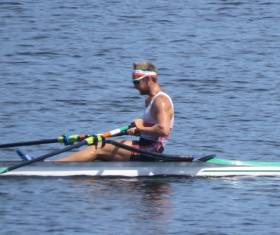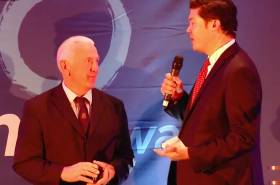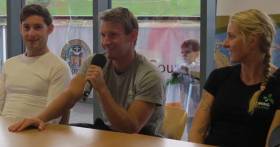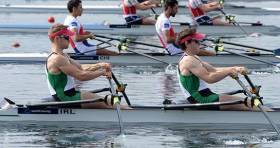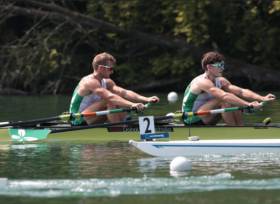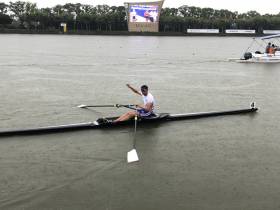Displaying items by tag: Gary O'Donovan
#Rowing: Gary O’Donovan took sixth place in his heat of the lightweight single sculls at the European Rowing Championships in Lucerne this morning. The Skibbereen man, competing for the first time at this level in a single, found himself at the back of the field early on and while he pushed into fifth he saw the race disappear from him in the final sprint. Martino Goretti of Italy set the early pace and won.
European Championships, Lucerne, Day One (Irish interest)
Men
Double – Heat One (First Two to A/B Semi-Finals; rest to Repechages): 1 Ireland (P Doyle, R Byrne) 6:26.53, 2 Romania 6:29.62.
Lightweight Single Sculls – Heat One (First Two to A/B Semi-Finals; rest to Repechages): 1 Italy (M Goretti) 7:05.54, 2 Switzerland (J Schaeuble) 7:06.73; 6 Ireland (G O’Donovan) 7:34.73.
Puspure Honoured for World-Beating Year
#Rowing: The Afloat Rower of the Year 2018 is Sanita Puspure. The Old Collegians competitor proved herself the best single sculler in the world. She took silver at the World Cup regattas in Belgrade and Lucerne, running the defending champion, Jeannine Gmelin of Switzerland, extremely close (.23 of a second) in the Lucerne final.
Working with coach Dave McKenzie McGowan and high performance director Antonio Maurogiovanni, who set a very heavy training schedule, Puspure decided to miss the European Championships so that she could concentrate on the World Championships in Plovdiv in Bulgaria in September. She won her heat and semi-final, and then overcame bobbly conditions in the final. She established a clearwater lead. Gmelin came back at her in the third quarter; Puspure was not for catching. She won by two lengths of clear water.
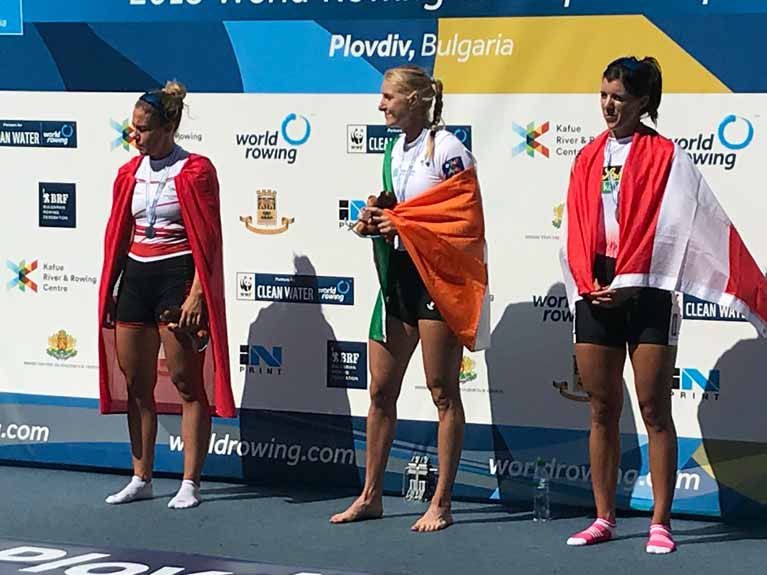 Sanita Puspure (centre) smiles after being presented with her gold medal at the World Championships. Jeannine Gmelin (silver) is on the left and Magdalena Lobnig (bronze) on the right. Photo: Liam Gorman
Sanita Puspure (centre) smiles after being presented with her gold medal at the World Championships. Jeannine Gmelin (silver) is on the left and Magdalena Lobnig (bronze) on the right. Photo: Liam Gorman
 Sanita with Daniella and Patrick, her children, after winning World Championship gold. Photo: Liam Gorman
Sanita with Daniella and Patrick, her children, after winning World Championship gold. Photo: Liam Gorman
The win was a twin highlight at the end of a wonderful year. The O’Donovan brothers, Gary and Paul, won the lightweight double sculls gold in Plovdiv, making history as the first Ireland crew to take World Championship gold in an Olympic boat. They overcame terrible conditions and a poor lane draw to win in the quarter-final. This was succeeded by a semi-final in which they looked tired and could only take third. The final saw them in the unfavoured lane six for the final.
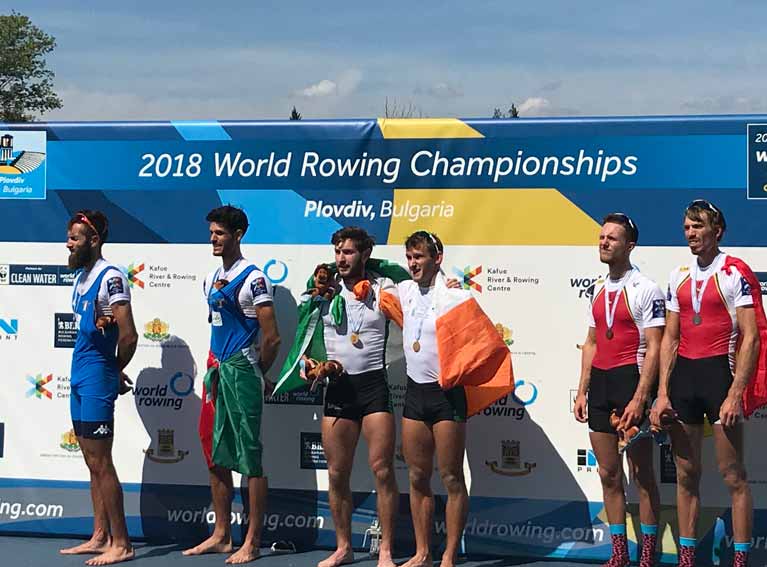 Ireland gold medalists Gary and Paul O'Donovan on the World Championship podium in Plovdiv, Bulgaria, with Italy (silver) and Belgium (bronze)
Ireland gold medalists Gary and Paul O'Donovan on the World Championship podium in Plovdiv, Bulgaria, with Italy (silver) and Belgium (bronze)
In a stirring race, the Skibbereen men saw off Italy. They would describe it as the best race they had ever rowed. They were outstanding in their steadiness, and over the second, third and fourth quarters they were the fastest crew. They took over the lead from Italy between 1200 and 1500 metres and rebuffed the charge by the men in blue to win by three-quarters of a length.
In a first for a women’s sweep crew from this island in an Olympic boat, Aifric Keogh and Emily Hegarty, the Ireland women’s pair, also reached an A Final at the World Championships. The World Under-23 Championships were also laden with success, with four A Finalists, gold for Shane Mulvaney and David O’Malley in the lightweight pair and silver for Miles Taylor, Niall Beggan, Ryan Ballantine and Andrew Goff in the lightweight quadruple.
Come the Fisa World Rowing Awards, Dominic Casey was honoured as the coach of the year.
In a season of success, Sanita Puspure is the Afloat Rower of the Year.
Afloat Rower of the Month awards: The judging panel is made up of Liam Gorman, rowing correspondent of The Irish Times, and David O'Brien, editor of Afloat magazine. Monthly awards for achievements during the year appeared on afloat.ie.
Dominic Casey is the World Rowing Coach of the Year
#Rowing: Dominic Casey has been chosen as the World Rowing Coach of the Year. The Skibbereen man, who coached Paul and Gary O’Donovan to a World Championship gold medal this year, received the award at a gala in Berlin. He had also been nominated in 2016 and 2017. In these years he oversaw the first Olympic medal for Ireland rowing, when the O’Donovan brothers took silver in Rio de Janeiro, and a string of gold medals for Mark O’Donovan and Shane O’Driscoll in the lightweight pair. In 2017, lightweight single sculler Denise Walsh also took silver in the European Championships and a World Cup silver.
Other awards on a glittering night went to the Australian men’s four, who were named the male crew of the year ahead of Paul and Gary O’Donovan, and the Poland quadruple, who took the women’s crew of the year, an award for which Sanita Puspure was nominated.
The 2018 World Rowing Para Crew of the Year is the Dutch PR2 mixed double of Annika van der Meer and Corne de Koning. The Sri Lankan oarsman and university student, Amidu Silva, won the 2018 Filippi Spirit Award.
The World Rowing Sustainability Award was taken by Alan Robinson and Schuylkill Navy for Love Where you Row.
The 2018 Distinguished Service to International Rowing award was won by Borge Kaas Andersen of Denmark.
Ireland in Three Finals at World Rowing Awards
#Rowing: Sanita Puspure, the O’Donovan brothers and Ireland lightweight coach Dominic Casey have all been chosen as finalists for the World Rowing Awards 2018. Puspure won gold in the women’s single sculls and Paul and Gary O’Donovan won the lightweight double, coached by Casey, at the World Rowing Championships.
Just two crews, along with Puspure, are in the running for Women’s Crew of the Year, while there are four crews in the finals of Men’s Crew of the Year and for Coach of the Year. Casey has reached the final three years in-a-row.
The awards will be presented on November 23rd in Berlin.
Finalists for the 2018 World Rowing Awards
Women’s Crew of the Year
- Caileigh Filmer, Hillary Janssens, Canada, Women’s pair
- Sanita Puspure, Ireland, Women’s single sculls
- Agnieszka Kobus-Zawojska, Marta Wieliczko, Maria Springwald, Katarzyna Zillmann, Poland, Women’s quadruple sculls
Men’s Crew of the Year
- Joshua Hicks, Spencer Turrin, Jack Hargreaves, Alexander Hill, Australia, Men’s four
- Jason Osborne, Germany, Lightweight men’s single sculls
- Johannes Weissenfeld, Felix Wimberger, Maximilian Planer, Torben Johannesen, Jakob Schneider, Malte Jakschik, Richard Schmidt, Hannes Ocik, Martin Sauer (coxswain), Germany, Men’s eight
- Paul O’Donovan, Gary O’Donovan, Ireland, Lightweight men’s double sculls
Para-rowing Crew of the Year
- Perle Bouge, France, Para PR2 women’s single sculls
- Ellen Buttrick, Grace Clough, Oliver Stanhope, Daniel Brown, Erin Wysocki-Jones (coxswain), Great Britain, Para PR3 mixed coxed four
- Annika van der Meer, Corne de Koning, Netherlands, Para PR2 mixed double sculls
Coach of the Year
- Uwe Bender, Germany, Men’s eight
- Dominic Casey, Ireland, Men’s pair, lightweight men’s and women’s double sculls, lightweight men’s quadruple sculls
- Jan Klerks, Netherlands, Para-rowing team
- Laurel Korholz, United States, Women’s four, women’s single sculls
2018 Sustainability Award
- “Pushing for a Clean Sweep”, National Schools Regatta, Great Britain
- “Partnership with Waikato Water Authority”, Rowing NZ, New Zealand
- “Love Where you Row”, Alan Robinson/Schuylkill Navy, United States
O'Donovan Brothers & Puspure Chosen as Afloat Rowers of Month
#Rowing: Ireland’s gold medallists at the World Championships, Paul and Gary O’Donovan and Sanita Puspure, are the Afloat Rowers of the Month for September.
The whole Ireland team performed with merit at the regatta in Plovdiv in Bulgaria and there were a number of outstanding placings. The men’s lightweight quadruple reached their A Final, while Philip Doyle and Ronan Byrne finished ninth overall in the men’s double sculls.
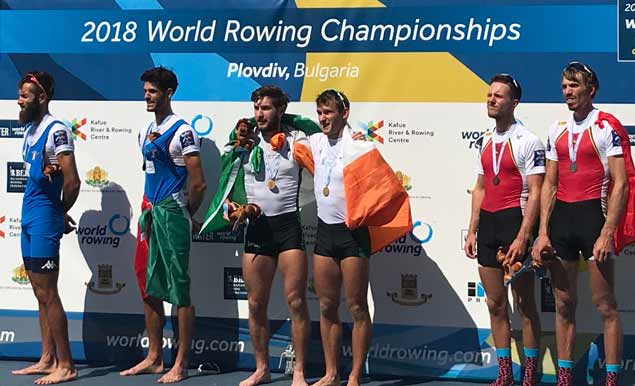 Gary and Paul on the podium in Plovdiv with Italy and Belgium Photo: Liam Gorman
Gary and Paul on the podium in Plovdiv with Italy and Belgium Photo: Liam Gorman
The women’s pair of Aifric Keogh and Emily Hegarty swept into the A Final, one of the real shocks of the Championships. They took sixth.
The O’Donovan brothers had to battle through a terrible lane draw on the Wednesday to reach Thursday’s semi-final. It left them tired and they made it through to the final by taking the third qualification place in the semi-final with just 1.52 seconds to spare over Poland. Come the final it was a step up; a step into history. They made light of their outside lane with a sweet and powerful row they deemed their best ever as a lightweight double. Italy could not live with it and Ireland had won their first ever gold medal in an Olympic event at a World Championships.
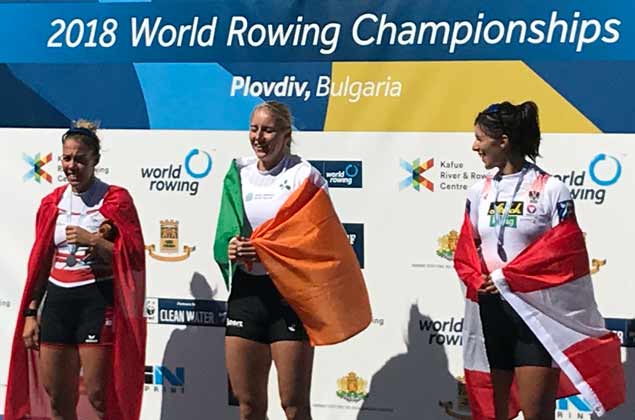 Sanita Puspure on the podium in Plovdiv Photo: Liam Gorman
Sanita Puspure on the podium in Plovdiv Photo: Liam Gorman
The women’s single sculls has been a fascinating event for years. Australia’s Kim Crow (now Brennan) was the star who shone all the way to a golden show in Rio in 2016; latterly Switzerland’s Jeannine Gmelin has been a winner. And now the time had come for Ireland’s Sanita Puspure. She won the heat and the semi-finals with elan, as if impatient to take on and beat Gmelin. She did this despite having to deal with choppy conditions in the final and she clipped a buoy. However, Puspure was never headed from early on, and she won with over two lengths to spare. For seven minutes and 20.12 seconds she was, indeed, dominant.
Congratulations to all the Ireland teams this season and to the Afloat Rowers of the Month, Sanita Puspure and Paul O’Donovan and Gary O’Donovan.
Rower of the Month awards: The judging panel is made up of Liam Gorman, rowing correspondent of The Irish Times and David O'Brien, Editor of Afloat magazine. Monthly awards for achievements during the year will appear on afloat.ie. Keep a monthly eye on progress and watch our 2018 champions list grow.
O'Donovans and Puspure Add Lustre as McCarthy and Cremen Start Season with Wins [UPDATE]
#Rowing: A big and enthusiastic crowd greeted rowers from the Ireland World Championships team at the National Rowing Centre today. Aifric Keogh and Emily Hegarty, who reached the final of the women’s pair, joined gold medallists Sanita Puspure, Paul O’Donovan and Gary O’Donovan.
The Minister of State with responsibility for Sport, Brendan Griffin, told the rowers and the crowd that he was fighting for funding at cabinet level, while the Cork County Mayor, Patrick Gerard Murphy, made an eloquent speech about how the present team inspire others.
Outside, the All Ireland Youth and Irish Open Regatta reflected the enthusiasm and ambition of the contenders for top spots. Lee woman Margaret Cremen was a convincing winner of the single sculls, while Fintan McCarthy – who was exempt, as he had competed at the World Championships – went ahead and won the men’s single.
Earlier Jack Dorney of Shandon and Aoife Lynch of Lee won the junior singles.
Irish Open Regatta, National Rowing Centre, Cork, September 29th
Men
Four: UCD (senior). Under-23: Coláiste Iognáid (jun).
Pair: NUIG (D Buckley, E Whittle; sen). Under-23: UCD. Jun: Commercial.
Sculling
Double: St Michael’s/UCC (sen). Under-23: Three Castles (jun)
Single: Skibbereen (F McCarthy; sen). Under-23: Queen’s (M Taylor). Jun: Enniskillen (O Donaghy)
Women
Four: Colaiste Iognaid A (jun)
Pair: UCC/Skibbereen (T Hanlon, N Casey; sen). U-23: Bann/Neptune. Jun: St Michael’s A.
Sculling
Double: Neptune/Bann (sen). U-23: Killorglin (jun).
Single: UCC (M Cremen, Under-23). NUIG (O’Connor; first senior). Jun: Lee (A Lynch).
Youth Regatta (Selected)
Men
Sculling, Quadruple, Junior 16, coxed: St Michael’s. Single, Jun 16: Kenmare (Kelly)
Women
Sculling, Quadruple, Junior 16, coxed: St Michael’s. Single, Jun 16: Lee Valley (Davis)
Brilliant Performance Yields World Championship Gold for O'Donovan Brothers
#Rowing: Ireland won gold at the World Rowing Championships with another brilliant row by the O’Donovan brothers. The Ireland lightweight double were in one of the unfavoured lanes - lane six - after taking third in their semi-final. But when it mattered they won.
Italy set off fast, but the O’Donovans chased them down and caught them in coming into the final quarter. They then produced their fastest 500 metres of their race to cross the line first and thrill the roaring crowd.
Italy took second, Belgium third. Before the race, Norway had to replace Kris Brun with Jens Holm.
World Rowing Championships, Plovdiv, Bulgaria, Day Seven (Irish interest):
Men
Lightweight Double Sculls – A Final: 1 Ireland (G O’Donovan, P O’Donovan) 6:06.81, 2 Italy 6:08.31, 3 Belgium 6:11.25.
Women
Pair – A Final: 1 Canada 6:50.67, 2 New Zealand 6:52.96, 3 Spain 7:04.60; 6 Ireland (A Keogh, E Hegarty) 7:15.70.
O'Donovans Qualify for World Championship Final with Third Place
#Rowing: Paul O’Donovan and Gary O’Donovan finished third in their semi-final and qualified for the A Final of the lightweight double sculls at the World Rowing Championships in Plovdiv. Italy were the early leaders and held on even as the O’Donovan brothers produced a good middle third. Coming up to the line, Belgium found a big finish and took second, while Ireland held off Poland to qualify.
World Rowing Championships, Plovdiv, Bulgaria, Day Five (Irish interest)
Men
Pair – Quarter-Final Four (Three to A/B Semi-Finals; rest to C/D Semi-Finals): 1 Canada 6:26.04, 2 New Zealand 6:30.36, 3 Czech Republic 6:35.01; 5 Ireland (M O’Donovan, S O’Driscoll) 6:44.28.
Double Sculls – Repechage Four (First Two to A/B Semi-Final):
Ireland (P Doyle, R Byrne) 6:16.96, 2 Bulgaria 6:20.15.
Lightweight Double – Semi-Final Two (Three to A Final; rest to B Final): 1 Italy 6:21.94, 2 Belgium 6:22.83, 3 Ireland (G O’Donovan, P O’Donovan) 6:23.78.
Women
Pair – Semi-Final (Three to A Final; rest to B Final): 1 Ireland (A Keogh, E Hegarty) 7:14.67, 2 Italy 7:14.99, 3 Spain 7:15.30.
O'Donovans Speed into Quarter-Finals at World Rowing Championships
#Rowing: Ireland’s Paul O’Donovan and Gary O’Donovan won their heat with a sparkling performance at the World Rowing Championships in Plovdiv. Germany’s newly-formed lightweight double of Jonathan Rommelmann and Konstantin Steinhuebel seemed set to give the Ireland crew a test, leading through half way and 1500 metres. But the O’Donovans had much better base speed and left their rivals behind in the final quarter. Portugal and Argentina also qualified for the quarter-finals.
Denise Walsh and Aoife Casey finished fourth in their heat of the lightweight double sculls. The first two positions were the valuable ones, as they secured a place in the semi-finals. New Zealand, Australia and Canada fought it out, with New Zealand’s Zoe McBride and Jackie Kiddle securing a clear first, while Australia edged Canada out by .34 of a second. Walsh and Casey were over 10 seconds further back.
The women’s pair of Aifric Keogh and Emily Hegarty qualified from their heat for the semi-finals, finishing second, while the men’s pair (fifth) and double (second) will have to compete in repechages.
World Rowing Championships, Plovdiv, Bulgaria, Day One (Irish interest)
Men
Pair – Heat Four (First Four to Quarter-Finals; rest to Repechage): 1 Canada 6:20.46, 2 South Africa 6:21.85, 3 France 6:25.43, 4 Belarus 6:28.22; 5 Ireland (M O’Donovan, S O’Driscoll) 6:29.10
Double Sculls – Heat One (Winner to A/B Semi-Final; rest to Repechages): 1 New Zealand 6:02.23; 2 Ireland (P Doyle, R Byrne) 6:12.61
Lightweight Double Sculls – Heat Five (First Four to Quarter-Finals; rest to Repechage): 1 Ireland (G O’Donovan, P O’Donovan) 6:15.79, 2 Germany 6:19.23, 3 Portugal 6:21.55, 4 Argentina 6:30.24.
Women
Pair – Heat One (First Three to A/B Semi-Final; rest to Repechage): 1 New Zealand 6:56.06, 2 Ireland (A Keogh, E Hegarty) 7:11.51, 3 United States 7:13.02.
Lightweight Double Sculls – Heat Three (First Two to A/B Semi-Finals; rest to Repechages): 1 New Zealand 6:50.04, 2 Australia 6:51.11; 4 Ireland (A Casey, D Walsh) 7:02.25.
McKeown's Gold in China Brings Another Reward
#Rowing: The Rower of the Month for August is Sam McKeown. The Queen’s University, Belfast, student won gold in the single sculls final at the World University Rowing Championships in Shanghai. The Portadown man, representing Britain, came in ahead of Chinese and Finnish opponents.
It was another month when Irish rowers were prominent: a young team represented Ireland at the World Junior Championships, while Paul and Gary O’Donovan added a silver medal to their haul as they headed up the Ireland team at the European Championships.
Rower of the Month awards: The judging panel is made up of Liam Gorman, rowing correspondent of The Irish Times and David O'Brien, Editor of Afloat magazine. Monthly awards for achievements during the year will appear on afloat.ie. Keep a monthly eye on progress and watch our 2018 champions list grow.


























